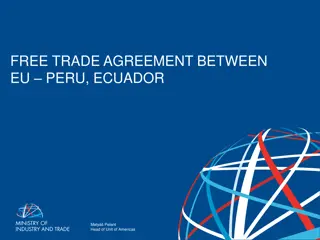Understanding Tariffs, Anti-dumping Duties, and Trade Barriers
Explore the key concepts of tariffs, anti-dumping duties, and barriers to digital trade in this presentation by Craig R. Parsons from Yokohama National University. Learn about the types of tariffs, the role of the WTO, and how countries can impose trade barriers. Discover the impact on service exports, digital trade services, and the actions taken by international trade agreements.
Download Presentation

Please find below an Image/Link to download the presentation.
The content on the website is provided AS IS for your information and personal use only. It may not be sold, licensed, or shared on other websites without obtaining consent from the author. Download presentation by click this link. If you encounter any issues during the download, it is possible that the publisher has removed the file from their server.
E N D
Presentation Transcript
An Introduction to Tariffs, Anti-dumping Duties and Barriers to Digital Trade Craig R. Parsons Yokohama National University Japan February 21st, 2022 Craig Parsons - Yokohama National University 1
In this presentation, I will pose and answer the following questions What is a Tariff? Are there different types of tariffs? What is the WTO? How easy is it for countries to raise tariffs, or other barriers to trade on products? What about service exports? Are there tariffs on those? What about digital trade and digital trade services? Are there barrier to trade in them? What can the WTO, TPP, RCEP, US-Japan trade agreement do about them? Craig Parsons - Yokohama National University 2
What is a tariff? A tariff is a tax on imports. (Tariff has a broader meaning in the English language and can also mean rate , possibly for another tax, or even for rates (e.g. telephone rates ($.05/minute) are sometimes called tariffs. e.g. Japanese has a 27% tariff on the importation of ski boots (but only 18.5% if from TPP11 members, such as Canada) Most electronics goods and parts imported to Japan already duty free (e.g. semiconductors are 0%). Japanese average tariff level is about 2-3 %, and even a bit lower in the US and EU (source: World Bank). Craig Parsons - Yokohama National University 3
Is it easy to raise a tariff? No. All countries who are members of WTO (formerly GATT until 1995) have promised NOT to raise tariffs from whatever their current levels are. 99% of the world s countries and economies are members of WTO. (Exceptions, e.g. North Korea and Iran) Then how did Tariff-man (former President Trump) put tariffs on China (and other countries) on steel and many other products of 10%, 25%? The Trump administration (and presidents before him, to a far lesser extent) used so-called TTBs (Temporary Trade Barriers) to raise tariffs. (n.b. Pres. Biden has not removed most of them yet.) Craig Parsons - Yokohama National University 4
Types of TTBs (Temporary Trade Barriers) Anti-dumping duties. If a firm sells it product (good) at a lower price in its foreign market than in its domestic market, it can be considered dumping , and the importing countries can put a Anti-dumping Duty (an import tariff) on that product. There are other TTBs, such as Countervailing Duties (CVD), Safeguard measures (in the US, these go by the names, Section 201, 232, etc.). Trump used all of these and more. CVDs: these are duties imposed on exports of a country that has been found to be subsidizing its exports. (e.g. US CVD against Chinese exports of solar-panels.) Traditional tariffs, as well as TTBS, are taxes on GOODS. Things. Merchandise. Not services trade. So, can these tariffs affect a firm like Amazon? Craig Parsons - Yokohama National University 5
Tariffs, and anti-dumping duties can affect production/investment decisions India has put up ADDs against import of solar panels (from China, Malaysia, etc.). Schneider Electric (a French engineering firm) has plans to install green energy grid in India. These Indian ADDs will raise costs of that project; may delay or cancel it. If anti-dumping duty in solar cells is a reality and the imposition is to the extent that has been reported then projects will definitely get delayed, but not derailed, Schneider Electric India s VP (Solar)Anurag Garg said today. https://solar.schneider-electric.com/anti-dumping-duty-could-delay-solar-power-projects-roll-out-anurag-garg-schneider-electric-india/ https://solar.schneider-electric.com/anti-dumping-duty-could-delay-solar-power-projects-roll-out-anurag-garg-schneider-electric-india/ Source: https://solar.schneider-electric.com/anti-dumping-duty-could-delay-solar-power-projects-roll-out- anurag-garg-schneider-electric-india/ Craig Parsons - Yokohama National University 6
What about other barriers to trade (NTBs)? There are many other barriers to trade other than trade (import) taxes. These are called Non-Tariff Barriers (NTBs.) Some of these are for valid health concerns. (e.g. food inspections for safety.) Other are disguised protection such as EU s ban on hormone-fed beef, but not pork. These can also raise the cost of doing business in a country. Question: do these barriers to trade affect a software firm such as Amazon? Craig Parsons - Yokohama National University 7
Services Trade as Opposed to Goods Trade The examples thus far have solely focused on the imports/export of GOODS. Traditional tariffs, as well as ADD, CVD, and original purpose of GATT/WTO all pertain to GOODS trade. But what about trade in SERVICES? GATT (General Agreement on Tariffs and Trade, evolved into WTO in 1995) Craig Parsons - Yokohama National University 8
Services Trade Historically, most of world trade was in GOODS, and SERVICES trade was a much smaller portion. However, the share of services trade is growing? In 1974 6%? In 2019, 14% (Source: World Bank) Of course, the internet, Zoom and easier telecommunication is a big part of the reason why. But what ARE Service imports/exports? Craig Parsons - Yokohama National University 9
Services Trade (examples) e.g. 1 If a US firm sells an insurance plan to a Japanese firm, that is a Service export for the US. (If it is sold by a US subsidiary in Japan, it is not.) e.g. 2 If a Japanese tourist spends money at hotel in Hawaii (the US), that is a US Service export. Air travel, transportation, banking, consulting etc. are many services that are increasingly being exported internationally. Are there any barriers to trade in these types of trade? Craig Parsons - Yokohama National University 10
Barriers to Trade in Services e.g. US air carriers cannot run domestic flights in Japan. For example, American airlines is not allowed to have flights between Naha and Tokyo. e.g. Many professional services have bans. Foreign licensed doctors cannot practice in the US, unless they have a US license. Like NTBs in Goods trade, some of these bans or restrictions are reasonable. Others are pure domestic protectionism. Craig Parsons - Yokohama National University 11
What about so-called Digital Trade? Q1: What is digital trade, exactly? Q2: Are there barriers to these products and services as in the case of NTBs in goods? Q3: Do the rules of international institutions (WTO) and international agreements (like RCEP and CP-TPP11) apply to this kind of international trade? Craig Parsons - Yokohama National University 12
What is Digital Trade (1 of 2)? One narrow definition of Digital Trade is the international sale of digital goods. For example, if you live in Japan and buy a CD (digital download) from a US or EU company, that is an example of digital trade. If you live in Australia, and buy a copy of some specialized accounting software from a company in Japan, this is also considered digital trade. Buying e-books from a foreign country is also a good example. The much broader definition, used by many including the OECD Both use the broad definition of digital (international) trade which encompasses both trade in digital goods (purchasing digital music) and digitally enabled trade (buying a hardcover book through Amazon which is shipped internationally). Craig Parsons - Yokohama National University 13
What is Digital Trade (2 of 2)? Digital trade involves digitally enabled or digitally ordered cross-border transactions in goods and services which can be digitally or physically delivered (Lopez-Gonzalez and Jouanjean, 2017[1]). Some estimates say that digital trade account for 25% of all world trade (https://www.gtipa.org/digital-trade). Other put that figure at a much higher 60%! https://trade.ec.europa.eu/doclib/docs/2021/february/tradoc_159433.pdf Craig Parsons - Yokohama National University 14
What is Digital Trade (alternative definition)? Digital trade has three components: trade in ICT products, international e- commerce, and cross-border data transfer Digital trade reduces transaction costs, facilitates participation in global value chains, and improves market access and reach https://english.bdi.eu/article/news/digital-trade-opportunities-and-risks/ Craig Parsons - Yokohama National University 15
There are many barriers to these three types of Digital Trade Such countries have very high barriers to digital trade (China, Russia, Turkey) Other countries are quite open to digital trade (Singapore, New Zealand) Craig Parsons - Yokohama National University 16
Most restrictive economies according to ECIPE China (1st) with a value of 0.7 Russia (2nd with a value of 0.46 India 0.44 43 Indonesia 0.43 41 Vietnam 0.41 (5th) Compare with: France 9th at 0.36 US 0.26 (22nd) Singapore (0.15) NZ at bottom, least restrictive (0.09) Craig Parsons - Yokohama National University 18
OECD measure has the following (5) sub-indices: Measuring Barriers to Digital Trade (OECD) 1) Infrastructure and connectivity (contains 13 measures half of which pertain to cross-border data flow restrictions ) 2) Electronic transactions (contains 7 measures) 3) Payment systems (3 measures) 4) Intellectual property rights (6 measures, half on enforcement, half on discrimination against foreign firms) 5) Other barriers affecting digitally enabled services. (7 measures. e.g. mandatory technology transfer, requirements to provide source code) Other is very important! Craig Parsons - Yokohama National University 19
Some specific examples of Digital Trade restrictions Norway, Singapore, etc. have free trade is digital IT equipment (like PCs and hard drives); Argentina has 13% tariff on some of these goods (PCs) . The City of Buenos Aires (Argentina) has a $0.50 Netflix tax China and Vietnam restrict telecommunications providers to local firms only. (This restrict sales, but also investment in this digital business.) Craig Parsons - Yokohama National University 20
More examples of Digital Trade restrictions? Restrictive practices (quotas, fees, visas) for use of foreign workers in IT. Romania. (A digital service . Programmers, for example.) Data localization . Data localization. Russia requires data be available (phone numbers etc) to Russian FSB (police). Turkey: data cannot be processed outside of Turkey. Data retention Russia: bloggers law must keep all info on Russian based servers for 6 months. Concersely: Right to be forgotten . In EU and elsewhere. China and Vietnam also have very strict data localization laws, which Amazon, Google, do not like. Craig Parsons - Yokohama National University 21
What is the position of a typical global tech firm, more generally? (again, from Schneider website) Relief of customs duties on digital products, thereby reducing unnecessary costs on the delivery of digital products and services. Enablement of the free flow of cross-border data and we caution against data localization laws, which only increase data barriers to consumers Preservation of corporate innovation through strong intellectual property protections that prohibit source code transfers as a condition for import, distribution, sale, or use, as well as ensuring robust patent lifespans and protections against counterfeit products (Parsons: This last one is related to so-called forced technology transfer . If you want to invest in our country, you have to share your tech, your code, etc. Craig Parsons - Yokohama National University 22
What can WTO (and TPP etc.) do about all of this? The GATT/WTO framework has worked surprisingly well to work out disputes in GOODS trade over the past 50-plus years (since 1947) For services (and intellectual property rights), agreeing upon and enforcing a set of rules has been a far greater challenge. Digital trade present yet even more challenges and the international rules are still much like the Wild West . Craig Parsons - Yokohama National University 23
With GATT/WTO GATS (General Agreement on Trade in Services), since 1995 TRIPS (Agreement on Trade-Related Aspects of Intellectual Property Rights) also since 1995 These two agreement try to address some of these issues, but opinions are far from unanimous. e.g. India and South Africa are often in opposition to the US and EU (and Japan) on IPR. (US wants it stricter, India wants it looser.) Craig Parsons - Yokohama National University 24
Within Free Trade Agreements As the little WTO has made little progress is setting new rules for Digital Trade, regional trade agreements have filled some of these gaps When the US-Canada-Mexico (NAFTA) agreement was revised (now USMCA) provisions/rules for Digital Trade were included. The recent US-Japan trade agreement also includes some digital trade provisions. The EU also has its own digital trade rules, which are sometimes at odds with the US (and often at odds wth China, Russia, etc.) CP-TPP also has provisions on digital trade, specifically on (free) e-commerce and (freedom from) data localization requirements Craig Parsons - Yokohama National University 25
Within the China-led RCEP (started in 2022) RCEP also has rules for e-commerce which are very similar to those of CP-TPP However, RCEP and the CPTPP differ substantially on provisions concerning computing facilities, cross-border transfer of data, and source code. In general, CPTPP is more free and also more comprehensive than RCEP in this regard (and many others.) Increasingly, there are many other bilateral agreements which are including digital trade provisions, many of which are more comprehensive than what is contained in CP-TPP. (For example, Singapore, Chile and NZ Digital Economy Partnership Agreement (DEPA) Signed in 2020. President Biden is discussing a possible Digital Agreement with India. If successful. This could help move the world into a US/EU/Japan style digital trade regime, rather than one dominated by the rules of RCEP (China.) Of course, many countries still do not and will not follow the rules and enforcement will always be an issue. Craig Parsons - Yokohama National University 26
Takeaway 1: World trade in GOODS is quite open and free, even, increasingly in emerging markets. Takeways (1 of 2): Takeaway 2: The recent Trump trade war still lingers, but it is expected to fade away, albeit slowly. Takeaway 3: Trade in services and digital trade is growing as a share of world trade. This is a good thing. Craig Parsons - Yokohama National University 27
Takeaway 4: But barriers to service and digital trade and numerous, growing and differ widely across countries. Takeways (1 of 2): Takeaway 5: Because the WTO is essential stalled, the future of rules for digital trade is being written in regional, bilateral and multilateral trade agreements Takeaway 6: From a tech firm point of view, it is their best interest to see the US/EU/Japan/Singapore models become more prevalent than the China model. However, China hopes to join CP-TPP, so there is hope to find some agreement even with China, who is a country willing to negotiate on trade issues. Craig Parsons - Yokohama National University 28
References Ferracane, M. F. and E. van der Marel (2021) Regulating Personal Data: Data Models and Digital Services Trade, Background Paper, Policy Research Working Paper 9596. For a nice taxonomy of digital trade and some empirical work as well: L pez Gonz lez, J. and J. Ferencz (2018), Digital Trade and Market Openness, OECD Trade Policy Papers, No. 217, OECD Publishing, Paris. http://dx.doi.org/10.1787/1bd89c9a-en Craig Parsons - Yokohama National University 29























